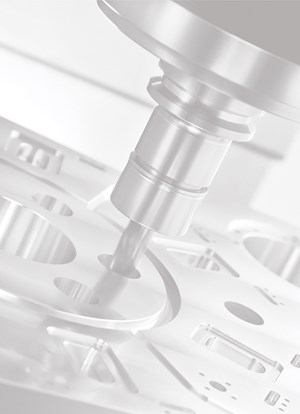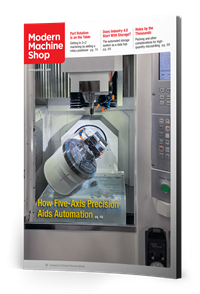Can U.S. Manufacturing Beat Trade Volatility? Lessons from Tormach's Global Strategy
As new tariffs loom, Tormach’s CEO shares how the company has adapted its supply chain to mitigate risk. By shifting production from Asia to Mexico and redesigning key products, the company is showing how strategic agility is the key to surviving and thriving in a volatile trade environment.
Share





For metalworkers, shop owners, engineers and, yes, metalworking trade magazines, much of the past decade has felt like an unrelenting stress test. Pandemics, geopolitical friction and tariffs have tested the resolve and staying power of our industry and those who serve it. With tariffs and trade wars again making headlines, a few numbers from the recent past are worth revisiting: The 2018 tariffs, including the Section 301 duties on Chinese goods, , according to the nonpartisan Tax Foundation nonprofit group. Now a new trade war is looming — including 25% tariffs on Mexico and Canada — ensuring a fresh round of challenges and opportunities.
The numbers alone, however, can’t capture reality on American shop floors. To understand how trade volatility reshapes the machine tool world, I sat down with Daniel Rogge, CEO of Tormach, a Wisconsin-based CNC machine-tool manufacturer that’s cutting its own distinctive path through these high-stakes changes.
Most readers know Tormach. Founded in 2002, Tormach is an employee-owned company that caters primarily to small shops, schools and universities, and garage shop hobbyists looking for accessible, affordable CNC machines. Tormach’s PCNC 440 CNC mill starts at just $7,000, for example, and the company’s latest VMC, the more robust 1500MX CNC mill, can still be purchased below $50,000. But beneath Tormach’s modest pricing scale you’ll find a strategic agility that may be helpful to American businesses facing similar turbulence. Rogge’s insights reveal how Tormach is not just surviving but adapting, by leveraging its unique business structure to navigate tariffs and shore up its own supply chain.
The 2018 Tariff Trigger
“In 2018, we had the 301 tariffs — that was a big cost hit to anybody doing low-cost production in China,” Rogge says. The Tax Foundation reports the average tariff rate on affected goods at 21%, with U.S. importers (including local distributors and manufacturers) footing the bill. Consumers felt it too. , dryers $92, as companies passed on costs to consumers. For Tormach, which was reliant on Asian partners for models like the PCNC 440, this was a wake-up call. “The tariffs hobbled one of China’s strengths, which is low cost,” Rogge says. “After six years, many businesses have concluded this is just the cost of doing business in China.”
Of course, this mindset change was a stated benefit of the Section 301 tariffs. When COVID-19 disrupted global supply chains, it exacerbated some issues facing machine-tool builders already working within tight margins. “You had China’s reaction to COVID — a country willing to just shut down production, period,” Rogge notes. For Tormach, sourcing from Asia meant delays and soaring shipping costs, up to “four times what I used to pay to bring parts across the ocean,” he adds. But Tormach didn’t sit still.
The Pivot: Enter Mexico and a Redesign
In 2023, Tormach acquired a partner factory in Guadalajara, Mexico, shifting key production areas from Asia. The 1500MX, with its epoxy granite base sourced from , rolled out as a North American-made machine, with nearly all components produced and assembled in Mexico and the United States. (Ball screws and linear motion components are still a challenge, Rogge says.) The proximity advantage of shifting production to Mexico helped slash lead times and shipping costs but also produced a bigger win: adaptability. “With Asian manufacturing, it can be six months to two years before we effect an improvement,” Rogge told me. “With Mexico, we’re the same company. Same time zone, everyone is fluent in English. We can roll feedback into changes in one to two months.”
There is a catch here, Rogge says: You can’t just transplant the designs that were being produced by Asian manufacturers. “It can’t be the same product,” he says. “Cast iron hand-scraping for accuracy and flatness — economically producing machine tool castings at a foundry in the United States is still a challenge.” So redesigning the 1500MX is exactly what Tormach did, swapping its cast iron base for epoxy granite. While the epoxy granite base is pricier, Rogge says it comes with a performance offset: The dense granite dampens vibrations and improves system performance while extending tool life. It provides thermal stability in variable temperature environments, it is corrosion-resistant and its cold-casting process is more environmentally friendly. Compared to its former model, the performance advantage of the new 1500MX — Rogge points to horsepower, feed rates and accuracy each increasing exponentially — helps counterbalance the price bump.
The Ownership and Openness Edge
Two other factors help keep Tormach strategically nimble: The company has been employee-owned since 2014, a fact that Rogge says fuels a culture of pride and innovation. Remote work thrives here, too, which allows the company to tap into talent from Mexico, the U.S. and Canada, especially for its administrative and sales teams.
Then there’s the open-source backbone of the company. Tormach’s control software — driven mainly by LinuxCNC, Machinekit and ROS — is freely available on GitHub, alongside its machine tools’ schematics and firmware. “We’re very much into right-to-repair,” Rogge says. “If a circuit board fails and you’re good with a soldering iron, we’ll provide the information you need to fix it.” This DIY ethos helps schools and small shops flatten learning curves more quickly, and sometimes results in improvement suggestions made directly by customers. “Because of that,” Rogge says, “we recently started publishing all of our schematics for our circuit boards and our firmware up on GitHub too, and we do that because it's important to contribute back to these communities.”
The New Trade War Looms
As of mid-March, 2025, 25% tariffs on goods from Canada and Mexico . A 25% duty on Mexico and Canada could hit Tormach twice: Once on Ohio-built bases heading south, then again on finished machines returning north. “The uncertainty is the biggest killer,” Rogge says. “If I knew it’d be in place April 2nd for three years, we could plan. Instead, we’re worrying about what we’d do if X, Y or Z happens.” If the Tax Foundation’s warning that these new tariffs could cut GDP by another 0.2% holds true, that certainly wouldn’t alleviate Rogge’s concerns. “What keeps me up at night is our customers won’t have enough money to buy our products, or anybody’s, if we get into a trade war with every nation.”
To offset these challenges, Tormach’s playbook is more North American production. No new Asian-sourced machines are planned — an outcome that aligns with goals of the initial 2018 tariffs on Chinese goods. “We can create a better product at a similar cost in Mexico,” Rogge says, adding that automation, not manual labor, will anchor any U.S. reindustrialization.
Read Next
2025 Top Shops Benchmarking Survey Now Open Through April 30
91ÊÓƵÍøÕ¾ÎÛ's Top Shops Benchmarking Survey is now open, offering metalworking and machining operations actionable feedback across several shopfloor and business metrics.
Read MoreView From My Shop: The Challenge of a One-Man Machine Shop
Mason Montalvo took up the challenge of starting his own shop running manual machine tools to produce complex parts.
Read More

















